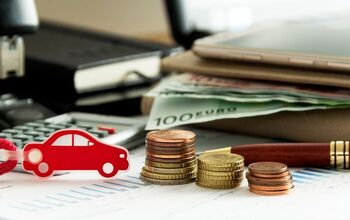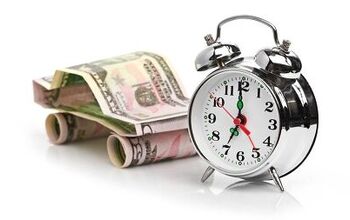What is Financing a Car? And What is a Good Financing Rate?

Whether you have found the perfect set of wheels or are just starting your car buying journey, knowing the ins and outs of automotive financing is an important part of making sure you get the best deal on your new (or new-to-you) ride. After all, the total price paid for the machine is only one piece of its total cost.
As we will discover in this article, the terms of financing can make a very large difference in the overall amount of money one spends on their new vehicle. Financing involves several moving parts, not the least of which are the interest rate and length on the loan.
Make friends with the calculator app on your phone; there’s a good chance that, in this case, using it could save you more than a bit of money in the long run.
What is the difference between financing and leasing a car?
arka38 / Shutterstock.com
Put simply, you’re essentially renting a car in the latter scenario. In some instances, the customer’s name doesn’t even appear on the ownership papers, a detail which can cause headaches when trying to register the car in another jurisdiction.
However, it would be helpful to add a bit more color to this definition. When leasing a vehicle, the payments are calculated using several variables, with the most important ones being the car’s price and expected value at the end of its lease, not to mention interest rates and other factors (there is actually a money factor in the calculation – seriously). In essence, one is paying the expected depreciation on a car during the life of a lease. That detail is the key to why leasing is so popular with certain businesses.
When financing a car, the customer negotiates a price for the vehicle, a sum which is then repaid over a certain amount of time at an agreed upon interest rate. The monthly (or bi-weekly) payments go toward paying back the total loan, an amount which gets smaller over time. At the end, one will own the car ‘lock, stock, and barrel’ after the loan has been paid off. The vehicle becomes an asset – something of value – that can be used to help make a down payment on another car, for example.
Both types of arrangements – financing and leasing – have their advantages and disadvantages, ones which we will explore in another article. For today, we’ll focus on financing.
What is a good financing rate for a car?
PHOTOBUAY / Shutterstock.com
This is a loaded question if there ever was one. In fact, it’s so loaded that it would take the better part of a one-ton truck’s towing capacity to haul it around. Hyperbolic similes aside, a good financing rate for a car is the lowest your credit score will allow.
We should walk the situation back a bit before deep-diving into this question. Financing is an important part of the car buying puzzle, one which will determine how much one pays for the vehicle in total. Thanks to financing, it is entirely possible that two otherwise identical cars, sold for the same price, can end up costing very different sums by the time they are paid off.
Let’s use a real-world example. Two people, John and Jane, have agreed to purchase two different 2018 Honda Civic sedans for the sum of $15,000 each. Jane has a good credit history with up-to-date payments while John has had some recent struggles after a job loss. In this scenario, Jane will likely be offered a more attractive interest rate on the Civic loan than John. Why? Lending institutions will classify John as a higher risk because of his credit problems.
SEE ALSO: Putting a Down Payment on a Car: Everything You Need to KnowWe’ll assume Jane was offered a finance rate of 3.99% while John was shown 9.99%. To help offset the higher rate and keep his payments down, John selects a 72 month term while Jane sticks to a 60 month note. Based on those numbers, Jane will have a biweekly payment of roughly $127 while John will be on the hook for $128 every two weeks. Doesn’t sound like much of a difference, right? Let’s do the math.
Over the life of Jane’s loan, she will pay about $16,560 for that new-to-her set of wheels. Meanwhile, the less favourable terms of John’s loan mean he will pay a total of $19,970 for his car. An extra $3400 is not insignificant, representing over 20 per cent of the car’s initial purchase price of fifteen grand.
Again, we ask: what is a good financing rate for a car?
Now you understand the ramifications of accepting a less than stellar rate, know that – as of this writing – used cars loans can be widely found by those of us with top-tier credit in the 3.5% to 4.0% range. Know that there may be other considerations to this figure, such as the age of a vehicle and how much – if any – money you’re fronting as a down payment. One’s income and the term of this loan also play significant factors.
It is highly recommended that a person be cautious who they permit to run a credit check on them. The internet is rife with anecdotes about an unsuspecting customer having their ‘file pulled’ at each car lot they visit, resulting in multiple credit inquiries on a single day. While it won’t sink the financial picture of someone with A1 payment history, does no favors to your overall credit score.
Still, you need to apply for a loan at some point. When you do, expect to offered a financing rate in line with the relative health of your credit history. For example, a top notch customer with no issues can currently expect a rate in the neighborhood of 4%, as mentioned above. Those with checkered pasts should brace themselves for at least double that figure. Also know that some lenders will post loans of 20% or more for high risk individuals.
What’s this I hear about 0% financing rate?
Good question. Those offers are generally made top A1 clients on new vehicles through the captive lending arm of a car manufacturer such as Ford Credit or Toyota Financial Services and are generally reserved for last year’s stock, unpopular vehicles, or on short term loans (36 months, for example). Be aware these offers may be made on the condition of foregoing some sort of incentive, so make sure to do your homework before signing on the dotted line.
Hang on a second – incentives affect the financing rate?
Billion Photos / Shutterstock.com
They sure can, particularly on new vehicles. There are a myriad of incentives when buying a new car – they’ll be covered in another article – but the most important ones on which to focus for this conversation are incentives offered only if a person is paying cash for the new vehicle. These discounts can often run well into the four-figure range and may only be available if the buyer doesn’t take the 0% interest rate offer.
For example – as of this writing, the 2020 Nissan Kicks SV is offered with a $1500 incentive and 0% financing over 60 months. However, if the buyer chooses to pay cash, that discount rises to $2500, which is a decent sum on a low-price crossover.
Since most people can’t dip into their savings can haul out the price of a new car, they’re likely to be securing a loan at a place other than the dealer in order to pay ‘cash’ for their new car and get the bigger incentive. However, do the math to make sure the interest rate you’re paying on the non-0% loan doesn’t outstrip the extra savings you’ve just collected from the larger incentive.
Are there other ways to get a better financing rate at a dealer?
There are, especially if you’re buying a used car. On those types of machines, many dealers choose to arrange financing through a third-party lender like a bank or credit union. Most dealerships have built up relationships with these services, often to the point where they may have a preferred lender. That title of ‘preferred’ can come from any number of variables, including ease of doing business or commission rates.
That’s correct – commission rates. It is not uncommon for a dealership to receive a fee for sending the ‘paper’ (car loan) through a particular financial institution. Even if that sum is only a couple of hundred dollars, it still adds to the overall profit made on the used vehicle you are buying.
Know that, in some instances, the dealership can accept a reduced fee in exchange for showing the customer a lower interest rate. For example, let’s imagine a dealer normally makes $300 per loan with the ABC Bank. But, in order for the dealer to earn your business, they need to show you a lower financing rate. It is possible that, in exchange for a 1% rate reduction, the dealer will reduce their fee to ABC Bank to $150. This cuts into the deal’s overall profit but if the dealership is close to making a target or need to move that particular car for some reason, it is in the realm of possibility they will make this move.
What are some other details I need to know when discussing finance rates?
comzeal images / Shutterstock.com
Lenders consider borrowers with extremely challenging credit history to be “subprime.” Banks and other institutions sometimes see them as customers who are far less likely than average to make monthly payments on time or completely pay off the loan. Some lenders won’t lend to subprime customer. Others will, but customers have to pay for the added credit risk by paying significantly higher interest rates than borrowers with better credit scores. Our example above of John and Jane buying similar Honda Civic sedans but paying markedly different total amounts is actually a lightweight example; using subprime numbers, the spread would be even more pronounced.
Lenders consider several factors when deciding what financing rate to charge their customers. At minimum, they have to cover the cost they themselves are paying the Federal Reserve, essentially an entity that lends them the money that they in turn lend to you. When the Fed keeps its interest rates low, lenders can keep a lid on the rates they charge as well.
It is also important to understand the loan’s term length also figures into the interest rate being charged. Essentially, a longer loan carries a higher risk that a customer will stop making their payments at some point. To offset this, a higher interest rate is charged to help the lender recoup more of the car’s value early in the loan, somewhat protecting them if the loan isn’t paid in full. For example, a four-year car loan will frequently have a lower financing rate than five- or six-year car loans.
Calculating a finance rate has that many variables?
So far as the customer is concerned, absolutely. Behind the scenes, you can expect there are several other conversations happening. Do your homework (reading this article is a great start), be prepared, and shop carefully. With those actions in your pocket, you’re sure to get a great deal.
Photo credit: wutzkohphoto / Shutterstock.com
Become an AutoGuide insider. Get the latest from the automotive world first by subscribing to our newsletter here.

Living in rural Canada, Matthew has immersed himself in car culture for over 30 years and relishes the thought of a good road trip. A certified gearhead, he enjoys sharing his excitement about cars and is very pleased to contribute at AutoGuide. Matthew is a member of Automotive Journalists Association of Canada (AJAC).
More by Matthew Guy




































Comments
Join the conversation